- Home
- Shoulder Exercises
- Scapula Stability
Scapular Stabilization Exercises
Written By: Chloe Wilson BSc (Hons) Physiotherapy
Reviewed By: SPE Medical Review Board

Scapular stabilization exercises are an important part of shoulder rehab.
Whether you have suffered an injury, your shoulder movement is limited or you have noticed that your shoulder blades stick out, shoulder blade exercises can make a big difference.
Here we are going to look at the best exercises for scapular stabilization, starting with how to set the shoulder blade in the correct position so you can get the most benefit from scapular strengthening exercises. You will then find a program of scapular stabilization exercises in a range of positions and with different loads to ensure you build up dynamic stability so the shoulder can move and function properly throughout its full range.
Why Is Scapular Stability Important?
The shoulder blades, aka scapula, are large triangular shaped bones that sit flat on your upper back over your ribs. They link with both the:
- Collar Bone aka Clavicle: to form the acromioclavicular joint
- Upper Arm Bone aka Humerus: forming the glenohumeral joint aka shoulder joint
The scapula provides a stable base that allows for the huge range of motion at the shoulder. Scapular stability depends on the co-ordinated activity of 17 muscles that work together to ensure correct positioning throughout the shoulder complex as the arm moves. This is known as scapulothoracic rhythm.
If there is weakness in the scapular stabilization muscles, it affects the positioning and mechanics of the shoulder complex which can lead to pain, dysfunction and injury. One of the most common problems is “winging scapula” where the shoulder blades lifts away from the rib cage which results in abnormal shoulder biomechanics.
Scapular instability has been linked to around 68% of rotator cuff problems, 100% of shoulder joint instability problems and is a contributing factor in most shoulder injuries. This makes scapular stabilization exercises a really important part of shoulder rehab, but they are sadly often overlooked.
Best Exercises For Scapular Stabilization
Here you will find a whole program of scapular stabilization exercises from beginners to advanced - there are 5 different groups to work through which get progressively harder.
A. Scapular Setting
B. Scapular Retraction Exercises
C. Wall Exercises For Scapular Stabilization
D. Resistance Band Scapular Strengthening
E. Advanced Scapular Stabilization Exercises
A. Scapular Setting
For scapular stabilization exercises to be effective, the shoulder blade needs to start in the right place so the best place to start is with scapula setting. This focuses on building up the strength and endurance of the lower trapezius muscles. Think of them like the shoulder blade’s anchor. As the arm moves, they hold the scapula in the right position and at the correct angle.
1. Scapula Squeeze
With all scapular stabilization exercises, the lower traps should be engaged – think of them as part of your core. The scapular squeeze is the perfect place to start for setting the shoulder blade in the right starting position.
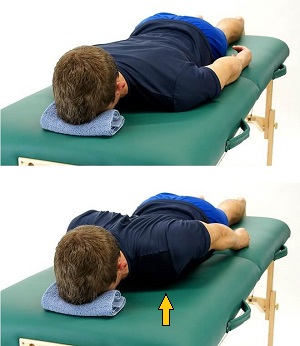
- Lie on your stomach with a rolled up towel underneath your forehead, both arms down by your sides, palms facing in
- Gently draw your shoulder blades back towards your spine, and down towards your waist. As you do this, you should feel the front of your shoulders lifting up off the bed
- Once you can happily do the movement, hold that position for a few seconds and then relax.
- Hold the position for 30 seconds and do 4 repetitions.
Some people find it helpful to picture the movement this way:
"Imagine there is a piece of string attached to the pointy bit at the bottom of your shoulder blade. Now imagine that the string is being pulled diagonally downwards and backwards drawing the shoulder blade towards the opposite back pocket of your trousers. That’s the movement you are looking for."
Top Tips: a. To start with, just focus on getting the movement action correct. You want the combination of moving the shoulder blades back AND down to be one fluid movement.
b. Focus on using the muscles between the lower part of the shoulder blades rather than the top or middle so you are targeting the lower traps.
c. Try and keep the rest of your body relaxed, with your head resting on the towel, and avoid the temptation to hold your breath!
d. Some people find it easier to have their hands tucked under their hips rather than by their side
You need good strength and endurance in the lower traps to provide a stable base for your shoulder blades, so make sure you can do 4 repetitions, holding the position for 30 seconds each time before trying harder scapular stabilization exercises.
B. Scapular Retraction Exercises
Once you’ve got the hang of using the lower traps to set the scapular into the right position, you are ready to go with the rest of these scapular stabilization exercises. Always start each one with a scapular squeeze as described above to activate those lower traps.
Top Tip: If there is any discomfort in your lower back while you do these, clench your glutes to hold your spine in a more neutral position as you do these scapular stabilization exercises.
1. Scapular Squeeze With Arm Lift
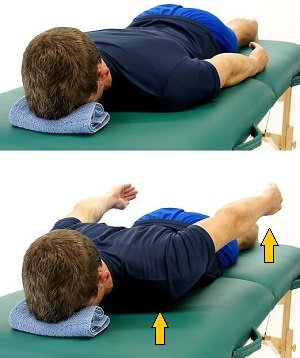
- Lie on your back, head resting on a towel, both arms by your side, palms facing in
- Set the shoulder blade with a scapula squeeze
- Maintaining that position, lift the lower arm and hand up about 2cms
- Hold the position, then lower the hand and arm and finally relax off the scapular squeeze
- Repeat 4 times aiming to build up to 30 second hold
Top Tips: Make sure the shoulders don’t droop forwards – keep using the lower traps to set the shoulder blade
Progressions: a. Pulse the arm up and down while you hold the position
b. Hold a weight on your hand while you do the exercise (with or without the pulses). If you don’t have one, use a can e.g. of baked beans or tinned fruit
2. Scapular Retractions “W” Position
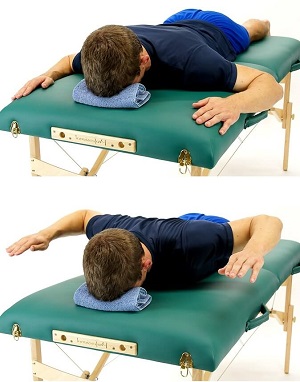
- Lie face down with your elbows bent and palms facing down
- Draw the shoulder blades back and down, letting the elbows lift up but keeping your hands on the bed initially. It will feel quite different than with your arms by your sides
- Then lift your hands so your forearms are parallel with the bed, hold and then lower
- Aim to hold for 30 seconds, 4 repetitions
Top Tip: Make sure you keep drawing the shoulder blades downward and towards your spine throughout, don’t let the shoulder start to droop
Progressions: a. Pulse the arms up and down at the end range of the movement
b. Hold a weight/can in your hand
c. Try this exercise in the “T” position with your elbows straight and your arms out to the side. Make sure your thumbs point up towards the ceiling throughout.
3. Scapular Retractions “Y” Position
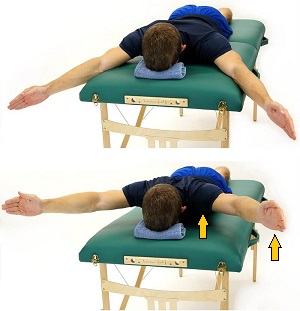
- Lie face down with your arms stretched out above your head as shown, thumbs pointing up towards the ceiling
- Draw the shoulder blades back and down and slowly lift your arms upwards towards the ceiling
- Aim to hold for 30 seconds, 4 repetitions
Top Tip: Keep thinking about the area between the bottom of your shoulder blades – that is the area you should be using to maintain stability with these scapular stabilization exercises
Progressions: a. Pulse the arms up and down as you hold the position
b. Hold a weight/can in your hand
NOTE: If you have an injury in your shoulder such as impingement syndrome, a frozen shoulder or a rotator cuff tear, this exercise might be difficult. If so, skip it – you don’t want to aggravate things.
4. Advanced Scapular Retraction Exercises
Once you are feeling confident with these scapular retraction exercises, you can make them harder by moving the shoulder through a greater range and taking it further away from your body. This is much more functional as scapular instability tends to cause most problems with activities such as lifting and racket sports, when the shoulder is moving through a large range of motion, away from the body.
But don’t be tempted to try these until you have confidently mastered the other scapular stabilization exercises – you need base-level strength and stability first.
Start out doing these without weights and once you feel confident, progress to holding a weight in your hand. Unless you have a narrow bed or table to do these on, you’ll need to work one arm at a time.
Lie face down, either resting your head on a towel or on your other hand, letting your arm hang down by your side. Always start by setting your shoulder blades - keep thinking about pulling them towards the opposite back pocket of your trousers.
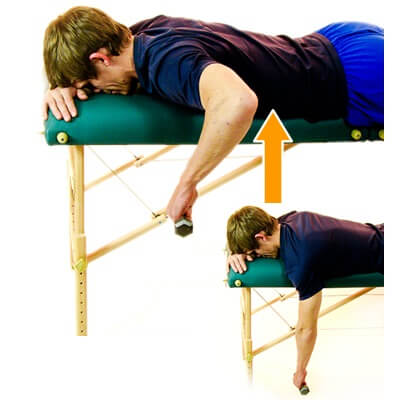
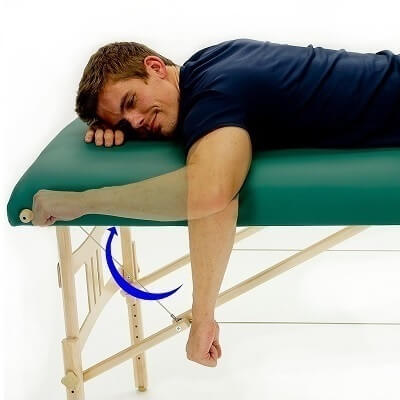
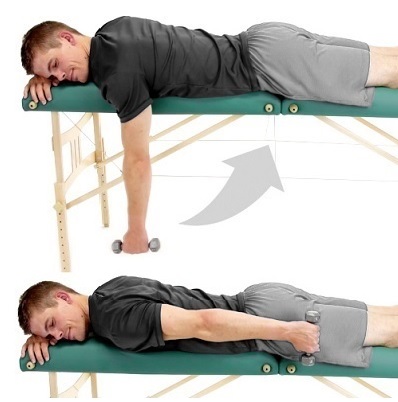
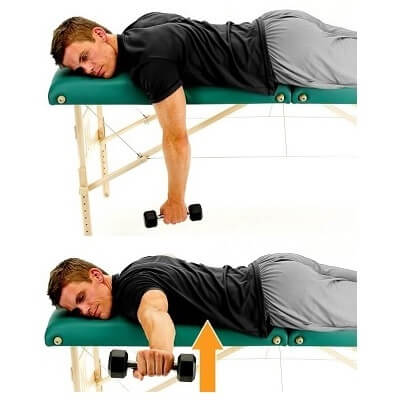
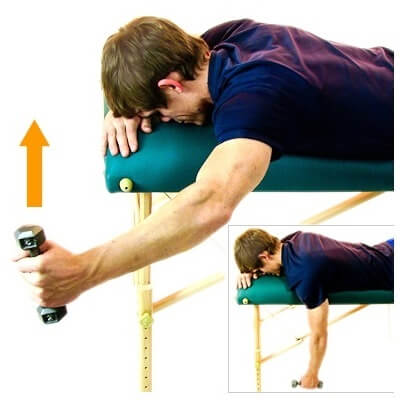
- Rows: Slowly raise your arm, letting your elbow bend
- External Rotation: Raise the forearm forward and upward towards the ceiling, keeping your upper arm on the bed throughout
- Extensions: Take your arm down and back until it is parallel with your body, keeping your elbow straight throughout
- “T” Position: Keeping your elbow straight, lift your arm out to the side, palm facing down
- “Y” Position: Keeping your elbow straight, lift your arm forwards and overhead
Hold the end position of each of these scapular stabilization exercises for 3 seconds, and aim to build up to 30 repetitions.
C. Wall Exercises For Scapula Stabilisation
If you have shoulder blade instability or winged scapula exercises against the wall can really help. Pushing against the wall while doing these scapular stabilization exercises helps to fix the shoulder blade in the right position making them a popular solution for how to fix winged scapula.
1. Ball Roll
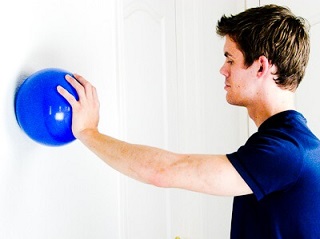
- Stand, holding a ball against the wall at shoulder height
- Draw your shoulder blades back and down to set the scapula and lean into ball
- Roll the ball in small circles, leaning through the ball throughout and maintaining the scapular squeeze
- Spend 2-3 minutes doing this
Progressions: a. Gradually increase the size of the circles
b. Vary the starting position of the ball e.g. change the height or move it sideways
2. Wall Press Ups
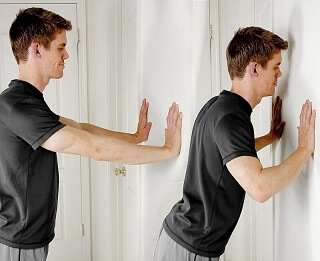
- Stand facing a wall and lift your arms forwards, elbows straight, so your hands just reach the wall
- Draw your shoulder blades back and down to set the scapula
- Bend your elbows slowly to bring your chest towards the wall, like you are doing a press up
- Then push back through your hands to come back up, maintaining the scapular squeeze throughout
- Repeat 20-40 times
Progression: Vary where on the wall you place your hands e.g. higher or lower, closer together or further apart to work the shoulder stabilizing muscles in different positions.
D. Resistance Band Scapular Strengthening
Resistance bands are a great tool to use with scapular stabilization exercises. They are cheap, versatile and easy to use and are an extremely effective tool for increasing scapula strength, stability, control and mass.
Now let’s look at some of the best exercises for scapular stabilization using a resistance band.
1. Resistance Band Rows
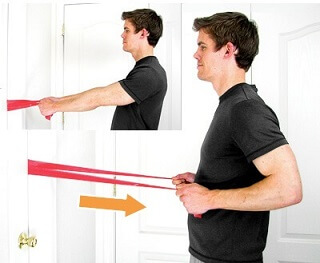
- Tie the resistance band to something stable e.g. door handle and hold it in both hands
- As you draw your shoulder blades back and down, pull the band back and let your elbows bend
- Hold for 3 seconds and slowly let the arms come forwards, keeping both scapula drawn back for as long as possible
- Keep your elbows near the side of your body throughout
Progression: Add in some pulses as you hold the position
Variations: Change the height of the band by changing what you fix it to.
2. Resistance Band Extensions
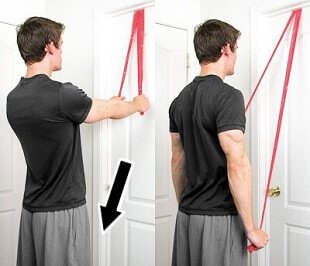
- Tie a large knot in the middle of the band, hook it over the top of a door and close the door to anchor the band in place
- Hold the band in both hands at shoulder height, elbows straight
- Draw your shoulder blades back and down, and pull the band down bringing your arms down by your side
- Hold for 3 seconds and slowly bring your arms back to the starting position
3. Chest Openings With Band
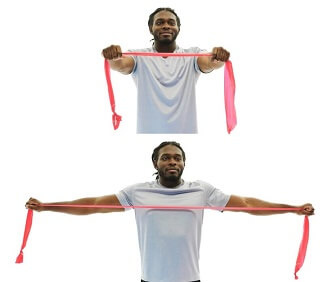
- Hold the band in front of your chest, elbows straight
- Pull your arms apart, out to the side, drawing your shoulder blades back and down
- Hold for 3-5 seconds and slowly bring your hands back together
Progression: Pulse the arms in and out as you hold the position
Variations: You can bias different shoulder stabilization muscles by changing your hand position e.g. palm up, palm down, palm in, palm out.
4. Resistance Band Wall Slides
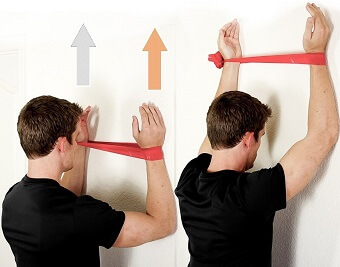
- Tie a small loop in the band and place it around your wrists
- Bring your hands shoulder-width apart, pulling out on the band, and place your forearms against the wall as shown
- Slide your arms up the wall without losing the tension in the band
- Hold for 3 seconds and slide your forearms back down the wall
E. Advanced Scapular Stabilization Exercises
The final stage with scapular stabilization exercises is to get the muscles working against your own body weight. Not only does the shoulder blade need to provide a stable base when the arm moves, it needs to do the same when using our whole body.
Not only will these exercises strengthen and stop your shoulder blades sticking out, they are also great for building upper body strength too.
1. Table Push Ups
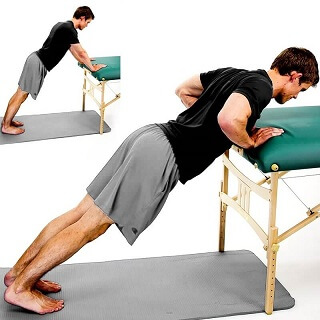
- Position yourself leaning forwards on a stable surface e.g. table as shown
- Draw your shoulder blades back and down into the scapular squeeze position
- Let your elbows bend and your chest drop and perform a push up
- Repeat 20-30 times
Top Tips: Don’t let your lower back arch and maintain the scapular squeeze throughout
Progression: The further your feet start from the table, the harder the muscles will have to work
2. Modified Plank Press Ups
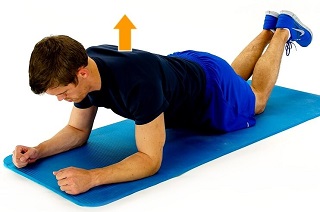
- Lie on your front, with your elbows and forearms tucked underneath you
- Lift your chest and hips into a half plank position so you are resting on your forearms and knees
- Holding that position, first draw your shoulder blades back towards your spine (retraction), then push them forwards in the opposite direction (protraction), lifting your upper back
- Repeat 15-30 times
Top Tips: Keep your tummy muscles tight and don’t let your back arch
Progressions: a. Start in a plank position, on elbows and toes as shown
b. Start in a half press-up position, on hands and knees as shown
c. Start in a full press-up position, on hands and toes as shown
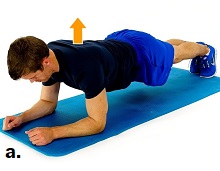
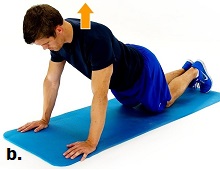
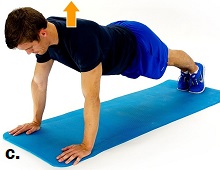
Alternately retract and protract the shoulder blades.
3. Plank Row
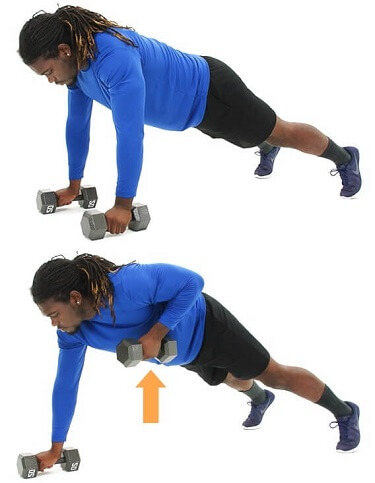
- Lie face down with your feet wide apart, hands directly underneath your shoulders and toes tucked under
- Push up into a full plank position and hold
- Lift up one arm, bending the elbow and draw the shoulder blade back and down
- Slowly lower the arm back down and repeat on the other side
- Repeat 20-30 times on each arm, alternating sides
Top Tip: Keep your back and pelvis stable and straight throughout
Progression: Hold a weight in each hand as you do this exercise
How To Fix A Winged Scapula
The scapular stabilization exercises will help you build up shoulder blade strength and stability and are a great way to fix a winged scapular.
Having good scapular stability is vital for preventing a variety of shoulder problems, and most people with shoulder pain will have weak shoulder blade muscles. Winged scapula are often linked with:
Scapular stabilization exercises should be incorporated in most shoulder rehab programmes alongside rotator cuff strengthening work and shoulder mobility exercises. It often takes 1-2 months of doing daily scapular stabilization exercises to notice a real difference, so stick with it - it will be worth it!
What Else Can Help?
Scapular stabilization exercises are an important part of the rehab process with most causes of shoulder pain. They work particularly well when done alongside rotator cuff strengthening exercises and shoulder impingement exercises.
Once you have regained some strength in the scapular stabilisers, it is important to add in stretches too. Tightness around the front of the shoulder and in the upper traps, typically from poor posture, affects how the shoulder blade moves so it is worth doing:
If you are not sure what is causing your shoulder pain, check out our shoulder pain diagnosis section for help working out what is wrong, or find out more about common shoulder problems and how to treat them. Or if you have any lumps or bumps in the area, check out the lump on back of shoulder article.
Related Articles
References
1. Archives of Physical Medicine and Rehabilitation. Effects of Scapular Stabilization Exercise Training on Scapular Kinematics, Disability, and Pain in Subacromial Impingement: A Randomized Controlled Trial. Elif Turgut, PT, PhD,a Irem Duzgun, PT, PhD,a Gul Baltaci, PT, PhDb. 2017
2. Physical Therapy & Rehabilitation Journal. Critical and Theoretical Perspective on Scapular Stabilization: What Does It Really Mean, and Are We on the Right Track? Kevin J. McQuade, John Borstad, Anamaria Siriani de Oliveira. August 2016
Page Last Updated: May 2nd, 2024
Next Review Due: May 2nd, 2026



